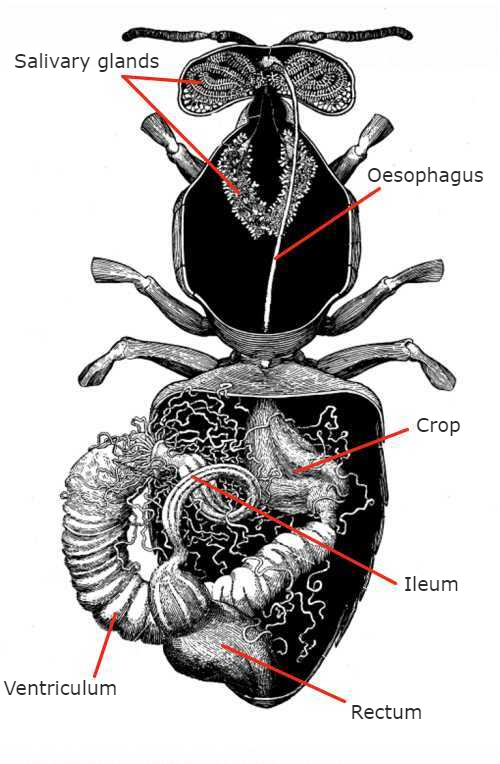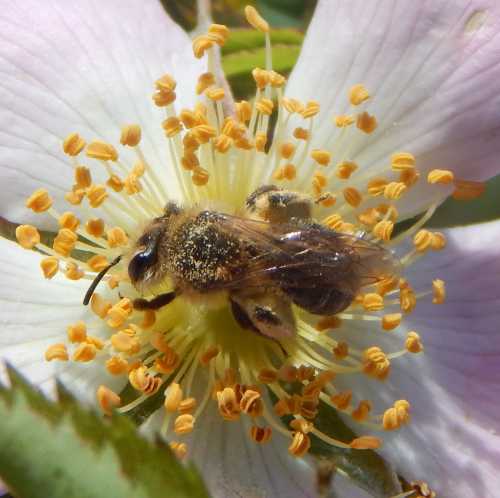Do Bees Have A Digestive System?
The short answer is:
Yes, bees have a digestive system. Digestion begins in the mouth and progresses through the foregut, midgut and hindgut.
Digestive System Of The Honey Bee
Bees take pollen and nectar into the mouth. Salivary glands in the head and thorax help to break down food, which progresses through the digestive tract.
The salivary glands of honey bees have been found to contain enzymes that aid digestion of food: invertase (breaks down sugars), glucose oxidase and amylase (breaks down starch)1.
The Honey Bee Digestive Tract
The digestive tract of the honey bee is divided into three compartments2:
- the foregut;
- the midgut and
- the hindgut.
Bees do not have a pancreas to assist in the digestive process, However, the three areas of the digestive system each provide different environments for the bacteria that work symbiotically to perform important digestive functions, such as absorption of nutrients and metabolism.
 After Snodgrass 1910 (ref 3)
After Snodgrass 1910 (ref 3)The foregut
The foregut comprises the mouth, oesophagus and crop (also commonly called the honey stomach). The crop is located in the abdomen. Food collected by the foraging workers is transported from the mouth, through the oesophagus and into the crop.
The crop is a muscle-lined organ. It has the ability to expand as nectar is gathered by bees as they forage. The crop also produces different enzymes to process nectar.
The midgut
Then, food and nutrients are moved into the midgut (or ventriculus). The midgut is the middle part of the tract, and is where most of the digestive process and absorption occur.
The epithelial layer of the midgut contains different enzymes that can metabolize protein, fat and sugar. Since most of the digestive process takes place in the ventriculus, it is also referred to as the ‘true stomach’.
The hindgut
The hindgut includes the ileum (small intestine) and the rectum. Anything that remains in the abdomen of the bee following digestion is moved to the ileum where any remaining nutrients can be collected, that were not absorbed in the midgut.
The rectum is located at the end of the GI tract, and like the crop, it can expand to accommodate waste products after food digestion. This enables bees to retain waste materials for some time, so that they can be disposed of through defecation outside of the nest or hive.
Resources
- Al-Sherif, A.A., Mazeed, A.M., Ewis, M.A., Nafea, E.A., Hagag, E.-S.E. and Kamel, A.A. (2017), Activity of salivary glands in secreting honey-elaborating enzymes in two subspecies of honeybee (Apis mellifera L). Physiol. Entomol, 42: 397-403. https://doi.org/10.1111/phen.12213
- Marfat Alatawy, Sanaa G. Al-Attas, Ahmad I. Assagaf, Abdullah Al-Shehri, Khalid M. Alghamdi and Ahmed Bahieldin. Gut Microbial Communities of Adult Honey Bee Workers (Apis Mellifera). June 2020. Biosciences Biotechnology Research Asia 17(2):353-362. DOI:10.13005/bbra/2838
- THE ANATOMY OF THE HONEY BEE. BY R. E. SNODGRASS, MAY 28, 1910.
If you found this page helpful or interesting, I'd really be grateful if you would share it with others - if not this page, perhaps another, such as Gardening For Bees.
Thank you so much :) .

